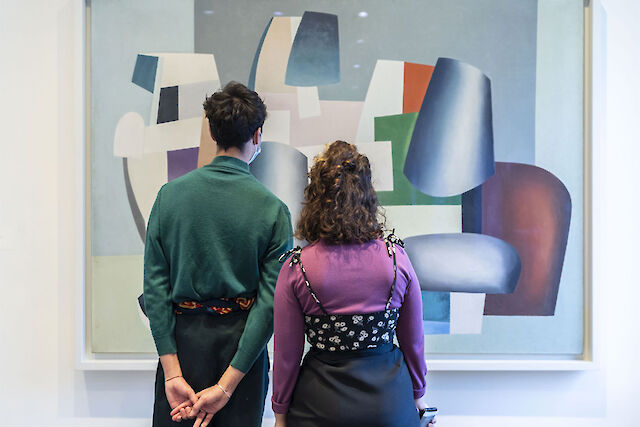
Inspiration, Sustainability, and Present Times. The three themes at the forefront of the Peggy Guggenheim Collection in 2021
Kindness, together with courage, means taking responsibility for one’s actions and place in the world, accepting the responsibility of being human.Gianrico Carofiglio, Della gentilezza e del coraggio, 2020
Venice, February 22, 2021 - Inspiration, Sustainability, and Present Times are three different themes united by an innate bond. They are words we hear repeatedly as a mantra in our daily lives and which we would like to further understand. The Peggy Guggenheim Collection selected and identified these words as a guide to 2021. The museum’s dialogue with the public, in-person, digitally and on social media networks will focus on these themes, which will also inspire its programming in the coming months.
A common thread will run concurrently: kindness. Kindness should not be intended as mere courtesy or benevolence, but as a new educational process in awareness and in individual and collective well-being, a virtue necessary for building high social impact and honest relationships, a force capable of creating a true and compassionate connection between human beings.
Professor Irene Baldriga from the Sapienza University in Rome inaugurated this journey on March 3 at 4:00pm with a live lecture on Zoom: Museums and Citizens. Beauty as a Key to Social Balance. The lecture was free and open to everyone, with registration required: https://www.guggenheim-venice.it/it/mostre-eventi/eventi/museo-e-cittadini/
/in·spi·ra·tion/. During the long lockdowns that forced museums and cultural institutions to remain closed, it was clear from the beginning that in moments of crisis and change art can be a source of comfort and inspiration. Even from a distance art unites and offers the opportunity to look beyond current problems. The continuation of the project Overcoming. Art Practices for the New Normal, conceived in 2020 together with Swatch Art Peace Hotel, fits into this context. The inspiration of the project is expressed through a dialogue between artists and young adults under 25 years of age. The universal quality of the artistic language and the exchange during the workshops give life to a continuous flourishing of ideas and reflections that are useful for building new scenarios arising out of the creative process and moving beyond the current crisis. From May 14-16, on the island of Certosa (Venice), Italian artist S.O.B. Stefano Ogliari Badessi will lead the fourth and final workshop in the series, Who Looks at What? The laboratory will examine the relationship between the city of Venice and water, focusing on the inextricable relationship that binds the city to the lagoon. The participants will work with recycled materials in the creation of two “floating eyes.” As Amedeo Modigliani said: “When I know your soul, I will paint your eyes.”
/ sus·tain’a·bil’i·ty/ Since 1980, when Palazzo Venier dei Leoni opened its doors as a museum, the Peggy Guggenheim Collection has looked at its many exhibitions and public programs to pursue its mission to educate its visitors and make them aware of issues such as quality education, social inclusion, gender equality, respect for cultural heritage and the environment. These are issues that fall within the broader concept of sustainability in the cultural sphere. To strengthen, share and continue this commitment, in 2018 the Peggy Guggenheim Collection joined ASviS, the Italian Alliance for Sustainable Development that promotes the 17 Goals of the United Nations 2030 agenda. Furthermore, over the last few years the museum has embarked on a fruitful collaboration with We Are Here Venice, a non-profit and independent association dedicated to the conservation and enhancement of Venice as a living and true city. Aware of the fundamental role of culture in the constitution of a sustainable development and an equitable society, throughout the year the Peggy Guggenheim Collection will present activities that contribute to the creation of a “cultural ecology,” thus enforcing the museum’s role as “initiator” of awareness and knowledge on present challenges. As mentioned above, this began on March 3 with the lecture Museums and Citizens. Beauty as a Key to Social Balance. Professor Baldriga, Senior Researcher (RTDB) at Sapienza University in Rome, Department of History, Anthropology, Religions, and Performing Arts (SARAS), illustrated the cultural relevance of education to cultural heritage with regard to communicating values of identity, belonging and social sustainability. The lecture highlighted how the aesthetic experience constitutes an indispensable factor in achieving the well-being of individuals and communities.
/pres·ent times/ In fulfilling its social function, the museum is understood above all else as an inclusive and accessible place, where visitors feel welcome and where the relationship with its art stimulates curiosity, the pleasure of discovery, and critical thinking. The museum is a place where knowledge of the past can become a source of reflection and inspiration for building our present and our future and where, regardless of the centuries that separate us from the artists and masterpieces on display, it can transmit a commonality of values and visions that continues to inspire the present in which we live. Hence the museum created a video tour that was presented on March 8. An exceptional guide, the director of the Peggy Guggenheim collection, Karole P. B. Vail, virtually accompanies the viewer to discover the masterpieces expertly collected by Peggy Guggenheim. Moreover, the four-part lecture series, Under Examination, will use the past as an asset to be preserved for the dissemination of knowledge today and into the future. Two experts in the field of restoration and conservation will analyze a series of works by four great masters of 19th- and 20th- century art. Paola Borghese, Restorer at the Pinacoteca di Brera in Milan, and Luciano Pensabene Buemi, Conservator at the Peggy Guggenheim Collection, will discuss artistic tricks, painting techniques and conservation interventions by four famous artists, Giovanni Boldini, Vasily Kandinsky, Giovanni Segantini and Pablo Picasso. Lectures will be held on Zoom in Italian. The March 10 and 17 appointments will be open to everyone upon registration. The April 14 and 28 appointments will be reserved for museum members.